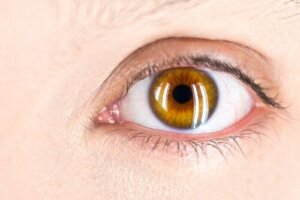What Is Fuchs' Dystrophy and Why Does It Appear?

Fuchs’ dystrophy is a disease that affects the cornea. This is a kind of lens, located in the anterior area of the eye, which is responsible for refracting light and directing its rays towards the retina.
The cornea is made up of different cell layers. What happens in this condition is that the cells of one of the layers (the endothelium) begin to die progressively. The problem is that vision is altered and becomes blurred.
The exact prevalence isn’t known. However, it’s important to treat it, as it can seriously affect visual capacity. In this article, we’ll tell you its possible causes in detail and the available treatment.
What is Fuchs’ dystrophy?
Fuchs’ dystrophy is a progressive and hereditary disease of the cornea that usually appears between 50 and 60 years of age. According to information from Expert Review of Ophthalmology, it’s a condition of the posterior cornea that manifests with a loss of endothelial cell density.
The endothelium is in contact with the aqueous humor, a fluid found in the anterior chamber of the eye. This layer of cells is responsible for expelling fluid out of the cornea so that it remains transparent and light can enter properly.
Read more: Alterations in the Position of the Eyelids
What happens in this disease is that these cells begin to die progressively. As a result, fluid accumulates in the cornea and it becomes thicker and thicker. A publication in the American Academy of Ophthalmology states that it’s divided into two stages.
- In the first stage – or early stage – symptoms may not appear at all or may be very mild. In fact, vision usually improves throughout the day.
- However, in the second stage, vision is often blurred throughout the day. During sleep, even more fluid tends to accumulate in the cornea. Therefore, the symptoms are more severe upon awakening.
Fuchs’ dystrophy often affects both eyes.
Symptoms of Fuchs’ dystrophy
Fuchs’ dystrophy has a slow and progressive development. The most characteristic symptom is blurred or hazy vision. Clinical manifestations often worsen upon awakening.
In the beginning, vision improves during the day. However, when the damage is already considerable, it remains blurred. Many patients report seeing small halos around lights or feeling dazzled.
In addition, due to fluid accumulation in the cornea, blisters may form on its surface. These can cause considerable pain or discomfort.
Causes and risk factors
In this disease, the endothelial cells inside the cornea progressively fail or die. The function of these cells, in addition to nourishing the cornea, is to prevent it from swelling. To do so, they draw the liquid from inside the cornea into the aqueous humor.
In this way, the cornea is kept at a limited and transparent thickness. Therefore, when these cells lose their functionality, the cornea becomes edematous, and the rays don’t reach the retina properly.
Although the exact cause of this situation isn’t known, it’s believed to have a significant hereditary component. However, the genetic basis is complex and there isn’t always a family history.
On the other hand, a number of factors have been identified that increase the risk of this condition. One of them, which we have already mentioned, is age. It most commonly begins in late adulthood.
Similarly, gender appears to be another risk factor. Its incidence is much higher in women than in men. It has also been found to be very frequent in the United States, but rare in oriental countries such as Japan or China.
How is Fuchs’ dystrophy diagnosed?
The diagnosis of Fuchs’ dystrophy can be complex, as many pathologies can lead to blurred vision. Therefore, the symptoms reported by the patient aren’t usually enough. Because of this, a series of complementary tests are usually performed to confirm the disease.
One of the basic tests is an examination of the cornea. According to the specialists at Mayo Clinic, this examination is usually performed with a slit lamp, which is a kind of optical microscope. It’s used to look for lesions in the cornea or to try to detect if it is swollen or has bulges.
In addition, a corneal tomography is usually performed. This is a test to evaluate whether there’s edema or not. Corneal pachymetry, on the other hand, is used to measure the thickness of this lens. As mentioned above, the cornea is usually thickened.
Finally, in some cases, a corneal cell count is performed. This isn’t a common procedure, but it allows counting the number of cells and their size to assess whether there has been a loss of cells.
Read more: Thyroid Eye Disease: Symptoms and Treatments
Available treatments
Fuchs’ dystrophy can become very disabling, because as the disease progresses, vision remains blurred throughout the day. In some cases, certain medical treatments are used to improve symptoms.
For example, soft contact lenses can be used. They help relieve corneal pain. The same applies to saline drops or ointments, which work by reducing the amount of fluid accumulated in the cornea.
Surgical treatment of the disease
The truth is that medical treatment is often insufficient. In many cases, certain surgical techniques are used to try to improve vision. Until recently, it was believed that the only curative therapeutic option was corneal transplantation.
However, there are now more specific techniques that specifically target the endothelial layer. This is the so-called inner corneal layer transplantation or Descemet’s membrane endothelial keratoplasty.
This technique consists of replacing only the innermost layer of the cornea, which is the one that’s damaged. It’s performed under local anesthesia. It has a faster recovery time than a complete corneal transplant.
Fuchs’ dystrophy is asymptomatic at first
It’s important to keep in mind that Fuchs’ dystrophy has a progressive and insidious course. In the early stages, it’s usually asymptomatic. The first signs may appear decades after the onset of the disease.
Therefore, it’s important to always consult an ophthalmologist in case of any manifestation. Other pathologies should be ruled out and treatment should be started as soon as possible to avoid complications.
All cited sources were thoroughly reviewed by our team to ensure their quality, reliability, currency, and validity. The bibliography of this article was considered reliable and of academic or scientific accuracy.
- Distrofia de Fuchs – Diagnóstico y tratamiento – Mayo Clinic. (2022, 18 mayo). https://www.mayoclinic.org/es-es/diseases-conditions/fuchs-dystrophy/diagnosis-treatment/drc-20352731
- Eghrari, A. O., & Gottsch, J. D. (2010). Fuchs’ corneal dystrophy. Expert review of ophthalmology, 5(2), 147–159. https://www.ncbi.nlm.nih.gov/pmc/articles/PMC2897712/
- Moshirfar M, Somani AN, Vaidyanathan U, et al. Fuchs Endothelial Dystrophy. [Updated 2022 Aug 1]. In: StatPearls [Internet]. Treasure Island (FL): StatPearls Publishing; 2023 Jan-. Available from: https://www.ncbi.nlm.nih.gov/books/NBK545248/
- Multimedia Extra A: Clinical Update. (2017, 8 agosto). [Vídeo]. American Academy of Ophthalmology. https://www.aao.org/eyenet/article/performing-dmek-stepbystep-guide
- ¿Qué es la distrofia de Fuchs? (2023, 10 abril). American Academy of Ophthalmology. https://www.aao.org/salud-ocular/enfermedades/distrofia-de-fuchs
- Thaung, C., & Davidson, A. E. (2022). Fuchs endothelial corneal dystrophy: current perspectives on diagnostic pathology and genetics-Bowman Club Lecture. BMJ open ophthalmology, 7(1), e001103. https://www.ncbi.nlm.nih.gov/pmc/articles/PMC9341215/
-
Vaiciuliene, R., Rylskyte, N., Baguzyte, G., & Jasinskas, V. (2022). Risk factors for fluctuations in corneal endothelial cell density (Review). Experimental and therapeutic medicine, 23(2), 129. https://www.ncbi.nlm.nih.gov/pmc/articles/PMC8713183/
This text is provided for informational purposes only and does not replace consultation with a professional. If in doubt, consult your specialist.









